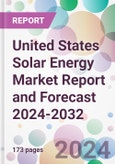Solar energy, characterised by the conversion of sunlight into electricity using photovoltaic (PV) panels or through concentrated solar power (CSP) systems, has become a cornerstone of the U.S. strategy to achieve energy independence and reduce carbon emissions. Its role in the transition to a more sustainable energy mix is increasingly vital, reflecting broader global shifts towards renewable resources.
As per the United States solar energy market analysis, there is a growing momentum for community solar projects, which allow multiple consumers to benefit from a single, shared solar array. This model is particularly appealing for renters, those with unsuitable roofs for solar panels, and low-to-moderate-income households, expanding access to solar energy beyond individual rooftop installations. Moreover, the integration of solar energy systems with battery storage is becoming increasingly popular. These combined solutions enhance the reliability and resilience of solar power, allowing for energy storage when production exceeds consumption and providing power during outages or periods of low sunlight.
Innovation is at the centre of the United States solar energy market expansion in recent years. Breakthroughs in PV efficiency, energy storage solutions, and solar-plus-storage systems are making solar energy more reliable and cost-effective. Additionally, the development of floating solar farms and bifacial solar panels offers new avenues for increasing solar capacity without competing for land resources.
Agri-photovoltaics, the co-location of solar panels with agriculture, is an innovative approach that maximises land use efficiency. This trend not only generates clean energy but also provides shade for crops, potentially increasing agricultural productivity while conserving water, and providing growth avenues for the United States solar energy market share. Bifacial solar panels, which capture sunlight from both sides, are also becoming more common due to their higher energy generation capacity compared to traditional monofacial panels. This technology can significantly improve the efficiency and output of solar installations.
The cost of solar PV installations has seen a dramatic decline over the past decade, making solar energy increasingly competitive with traditional energy sources. This trend is expected to continue, further driving the United States solar energy market growth. Beyond utility-scale projects, there is a rising demand for solar installations from the commercial and residential sectors. Companies and homeowners are turning to solar not only to reduce their environmental footprint but also to benefit from long-term savings on energy bills.
Federal tax credits, state-level renewable portfolio standards (RPS), and net metering policies have significantly contributed to the market growth. These initiatives, coupled with investments in solar research and development, underscore the government's commitment to supporting renewable energy.
As per the United States solar energy market outlook, the market is characterised by a diverse ecosystem of players, including solar panel manufacturers, project developers, installation companies, and energy service providers. Competition is driven by technological advancements, cost-reduction strategies, and the ability to provide comprehensive energy solutions.
With continued technological advancements, supportive policies, and increasing awareness of the benefits of renewable energy, the United States solar energy market is set to play a pivotal role in the U.S. energy landscape. The sector's growth will not only contribute to meeting the country's climate goals but also spur economic development and job creation in the renewable energy sector.
Market Segmentation
The market can be divided based on technology, solar module, application, and region.Market Breakup by Technology
- Concentrated Solar Power Systems
- Photovoltaic Systems
Market Breakup by Solar Module
- Monocrystalline
- Polycrystalline
- Cadmium Telluride
- Amorphous Silicon Cells
- Others
Market Breakup by Application
- Residential
- Commercial
- Industrial
Market Breakup by Region
- New England
- Mideast
- Great Lakes
- Plains
- Southeast
- Southwest
- Rocky Mountain
- Far West
Competitive Landscape
The report looks into the market shares, plant turnarounds, capacities, investments, and mergers and acquisitions, among other major developments, of the leading companies operating in the United States solar energy market. Some of the major players explored in the report are as follows:- JinkoSolar Holding Co., Ltd.
- Trina Solar Co. Ltd.
- Canadian Solar Inc.
- NextEra Energy Resources, LLC
- Avantus LLC
- M. A. Mortenson Company
- SOLV Energy
- First Solar, Inc.
- SunPower Corporation
- Hanwha Group
- Rosendin Electric, Inc.
- Others
This product will be delivered within 5-7 business days.
Table of Contents
Companies Mentioned
- JinkoSolar Holding Co. Ltd.
- Trina Solar Co. Ltd.
- Canadian Solar Inc.
- NextEra Energy Resources LLC
- Avantus LLC
- M. A. Mortenson Company
- SOLV Energy First Solar Inc.
- SunPower Corporation
- Hanwha Group Rosendin Electric Inc.
Methodology

LOADING...








